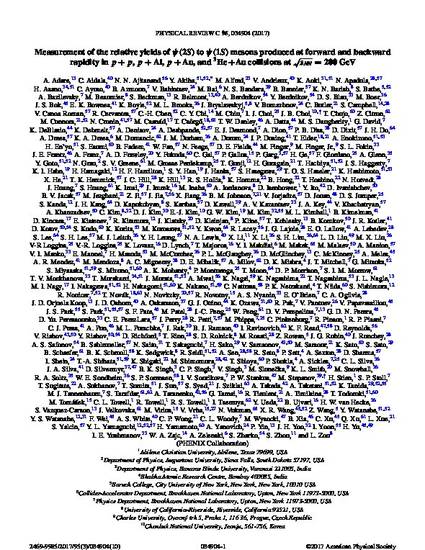
Article
Measurement of the relative yields of psi(2S) to psi(1S) mesons produced at forward and backward rapidity in p plus p, p plus Al, p + Au, and He-3+Au collisions at root S-NN=200 GeV
Physical Review C
Document Type
Article
Publication Version
Published Version
Publication Date
3-9-2017
DOI
10.1103/PhysRevC.95.034904
Abstract
The PHENIX Collaboration has measured the ratio of the yields of psi(2S) to psi(1S) mesons produced in p + p, p + Al, p + Au, and He-3+Au collisions at root S-NN = 200 GeV over the forward and backward rapidity intervals 1.2 < | y | < 2.2. We find that the ratio in p + p collisions is consistent with measurements at other collision energies. In collisions with nuclei, we find that in the forward (p-going or He-3-going) direction, the relative yield of psi(2S) mesons to psi(1S) mesons is consistent with the value measured in p + p collisions. However, in the backward (nucleus-going) direction, the psi(2S) meson is preferentially suppressed by a factor of similar to 2. This suppression is attributed in some models to the breakup of the weakly bound psi(2S) meson through final-state interactions with comoving particles, which have a higher density in the nucleus-going direction. These breakup effects may compete with color screening in a deconfined quark-gluon plasma to produce sequential suppression of excited quarkonia states.
Copyright Owner
American Physical Society
Copyright Date
2017
Language
en
File Format
application/pdf
Citation Information
Andrew Adare, Nicole Apadula, Sarah C. Campbell, John C. Hill, et al.. "Measurement of the relative yields of psi(2S) to psi(1S) mesons produced at forward and backward rapidity in p plus p, p plus Al, p + Au, and He-3+Au collisions at root S-NN=200 GeV" Physical Review C Vol. 95 (2017) p. 034904-1 - 034904-10 Available at: http://works.bepress.com/craig-ogilvie/70/

This is an article from Physical Review C 95 (2017): 034904-1, doi:10.1103/PhysRevC.95.034904. Posted with permission.